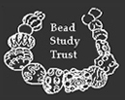Glass Beads from Anglo-Saxon Graves
Birte Brugmann, 2004. https://doi.org/10.5284/1000232. How to cite using this DOI
Data copyright © Birte Brugmann unless otherwise stated
This work is licensed under the ADS Terms of Use and Access.

Primary contact
Birte
Brugmann
Ernst-Schneller-Str. 7
06114 Halle (Saale)
Germany
Resource identifiers
- ADS Collection: 357
- DOI:https://doi.org/10.5284/1000232
- How to cite using this DOI
Overview
This study is based on a Sample of some 32,000 beads of the 5th to 8th centuries, found at 106 sites in nine Anglo-Saxon regions. 56% of the beads are made of amber, 43% of glass and 1% of other materials. Of the 13,000 or so glass beads, about two-thirds are assigned to one or other of the types defined in Chapter 5 of the publication associated with this archive. Distribution patterns suggest that some of the beads were manufactured in Anglo-Saxon England, while others were imported from or via the continent.
Most of the glass-bead types, as well as amethyst and cowrie shell rim beads, are suited to investigation by correspondence analysis, by which they are sorted into a chronological sequence. Six bead groups are assigned to three main phases and this chronological sequence can be correlated to continental frameworks:
- The Early or 'Migration' Period (Phase A: Bead Groups A1, A2 and part of A2b)
- An intermediate phase (Phase B: part of Bead Group A2b and Groups B1 and B2)
- The Final Phase (Phase C: Bead Group C)
Differences in regional Anglo-Saxon bead fashions are not as pronounced as in brooch fashion. In the early Phase A, bead fashion was dominated by mostly blue monochrome beads, which in 'Anglian' England are mixed with an insular production of polychrome types. Later in Phase A, amber beads dominated, especially in 'Saxon' England where they are combined with 'gold-in-glass' beads. In Phase B is witnessed an increased import of polychrome glass beads, especially into Kent and East Anglia. Phase C, however, shows an abrupt change in Anglo-Saxon bead fashion: amethyst beads are now present, but otherwise it seems to lose contact with continental fashion, showing rather vague links now to Scandinavia.
The online download (Table 11) lists the graves and unassociated beads in the sample and gives the number of beads per unit that fall into one of the type definitions in the printed Appendix. Details on the site names used in this table are given in table 2 of the printed publication.






